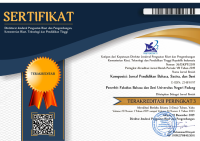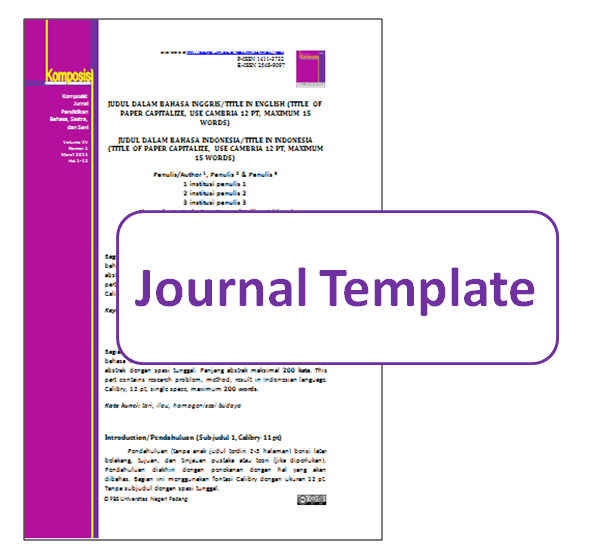Deep in the Diphthong Problem: A Study on Indonesian EFL Learners’ Pronunciation Development and the Influence of Individual Differences
 ), Intan Sofiana(2),
), Intan Sofiana(2), (1) Universitas Muhammadiyah Purwokerto
(2) Universitas Muhammadiyah Purwokerto
 Corresponding Author
Corresponding Author
Copyright (c) 2023 Komposisi: Jurnal Pendidikan Bahasa, Sastra, dan Seni
DOI : https://doi.org/10.24036/komposisi.v24i2.122553
Full Text:
 Language : en
Language : en
Abstract
The current study aims at investigating the development of Indonesian EFL learners' pronunciation in terms of diphthong. In this study learners' pronunciation were observed over a period of six months to see how they develop. Moreover, the influence of their linguistic background on the pronunciation development was also measured namely age of acquisition, native language, level of English accent and the extend of English exposure. The data of this study was collected using pronunciation tests and the Language History Questionnaire (LHQ). The participants involved in this research were 25 university English students who were taking Phonetics course. The collected data was then analyzed using SPSS. The analysis techniques of this study were descriptive statistics and multiple regression analysis. The study found that the learners' diphthong pronunciation did not develop significantly. Moreover, it even tends to have downward trend. Finally, according to the regression analysis, the aspect of learners' linguistic background that affected the most on their pronunciation development was their exposure to English.
Keywords
References
Aziez, F. (2021). The long-term impact of learner-learner interaction on L2 English development (Dissertation).
Boersma, P. & Weenink, D. (2022). Praat: doing phonetics by computer [Computer program]. Version 6.2.06, retrieved 23 January 2022 from https://www.praat.org.
Card, N. A., & Little, T. D. (2007). Longitudinal modeling of developmental processes. International Journal of Behavioral Development, 31(4), 297–302. https://doi.org/10.1177/0165025407077750
Caruana, E., Hospital, G., & Solli, P. (2015). Longitudinal studies robotic-assisted pulmonary resection atlas view project thoracic surgery view project. Article in Journal of Thoracic Disease, 7(11). https://doi.org/10.3978/j.issn.2072-1439.2015.10.63
Collier, V. (1988). The effect of age on acquisition of a second language for school.
Derwing, T. M., Thomson, R. I., & Munro, M. J. (2006). English pronunciation and fluency development in Mandarin and Slavic speakers. System, 34(2), 183–193. https://doi.org/10.1016/j.system.2006.01.005
Dhillon, B. P. S. (2016). Does Mother Tongue Affect the English Pronunciation? International Conference on Language, Education, Humanities and Innovation.
Donal, A. (2016). Indonesian students’ difficulties in pronouncing. Journal of English Education, 2(2).
Dosia, P. A., & Rido, A. (2017). Production of English diphthongs: a speech study. Teknosastik, 15(1), 21. https://doi.org/10.33365/ts.v15i1.17
Gilakjani, A. P. (2012). A study of factors affecting EFL learners’ English pronunciation learning and the strategies for instruction. International Journal of Humanities and Social Science, 2(3), 119–128.
Gilakjani, A. P., & Sabouri, N. B. (2016). Why is English pronunciation ignored by EFL teachers in their classes? International Journal of English Linguistics, 6(6), 195–208. https://doi.org/10.5539/ijel.v6n6p195
Harmer, J. (2007). The practice of English language teaching. Longman.
Hornby, A. S. (2008). Oxford advanced learner`s dictionary of current English. New York: Oxford University Press.
Ji, F. (2021). Investigating the influences of starting age on pronunciation: a comparative study of Chinese learners of English as a second language. Journal of Higher Education Research, 2(3). https://doi.org/10.32629/jher.v2i3.324
Kothari, C. R. (2004). Research methodology: methods and techniques (2nd ed., p. 37). New Age International (P) Limited, Publishers.
Li, P., Zhang, F., Yu, A., & Zhao, X. (2020). Language History Questionnaire (LHQ3): An enhanced tool for assessing multilingual experience. Bilingualism: Language and Cognition, 23(5), 938-944.
Lunkenheimer, E. (2018). Dynamic systems theory. In M. H. Bornstein (Ed.), The SAGE Encyclopedia of Lifespan Human Development (pp. 679–680). SAGE Publications, Inc.
Mukherjee, S. (2020). Second language (l2) development.
Rahman, A., & Tralala, L. N. (2021). EFL students’ pronunciation problems in presenting thesis proposal at tertiary level of English department. Jurnal Kependidikan: Jurnal Hasil Penelitian Dan Kajian Kepustakaan Di Bidang Pendidikan, Pengajaran Dan Pembelajaran, 7(3), 576. https://doi.org/10.33394/jk.v7i3.3921
Rasaki, I. H., Ikhsan, M. K., & Pratiwi, A. (2018). Students’ inconsistency problems in pronouncing diphthong sounds in reading aloud activity at English department of STKIP PGRI Sumatera Barat. tell-us journal, 4(2), 130–140. https://doi.org/10.22202/tus.2018.v4i2.2800
Roach, P. (2009). English phonetics and phonology : a practical course (4th ed.). Cambridge University Press.
Saadah, F., & Ardi, H. (2020). The analysis of students’ pronunciation error on English diphthong made by fifth semester of English language education program Universitas Negeri Padang. Journal of English Language Teaching, 9(1), 188. https://doi.org/10.24036/jelt.v9i1.107829
Saito, K., Trofimovich, P., & Isaacs, T. (2015). Second language speech production: Investigating linguistic correlates of comprehensibility and accentedness for learners at different ability levels. Applied Psycholinguistics, 37(2), 217–240. https://doi.org/10.1017/s0142716414000502
Tyler, A. (2010). Usage-Based approaches to language and their applications to second language learning. Annual Review of Applied Linguistics, 30, 270–291. https://doi.org/10.1017/s0267190510000140
Verspoor, M., & De Bot, K. (2011). A dynamic approach to second language development : methods and techniques. Benjamins. Amsterdam.
Verspoor, M. H., & Hong, N. T. P. (2013). A Dynamic Usage-Based approach to communicative language teaching. European Journal of Applied Linguistics, 1(1), 20–54. https://doi.org/10.1515/eujal-2013-0003
Wahyukti, T., & Kusumastuti, D. (2020). English phonetics. Universitas Muhammadiyah Purwokerto.
Yates, L., & Zielinski, B. (2009). Give it a go: teaching pronunciation to adults (p. 11). Adult Migrant English Program (Amep) Research Centre, Macquarie University.
Yoshida, M. T. (2005). Understanding and teaching the pronunciation of English. Available at http://teachingpronunciation.weebly.com/uploads/9/5/9/1/9591739/understanding_and_teaching_the_pronunciation_of_english-16pt.pdf
 Article Metrics
Article Metrics
 Abstract Views : 743 times
Abstract Views : 743 times
 PDF Downloaded : 86 times
PDF Downloaded : 86 times
Refbacks
- There are currently no refbacks.
Copyright (c) 2023 Komposisi: Jurnal Pendidikan Bahasa, Sastra, dan Seni

This work is licensed under a Creative Commons Attribution-NonCommercial 4.0 International License.












